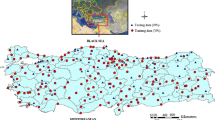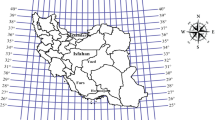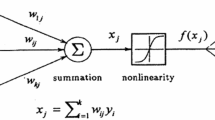Abstract
The accurate prediction of daily reference crop evapotranspiration (ETO) enables effective management decision-making for agricultural water resources; this is crucial for developing water-efficient agriculture. To improve the accuracy of ETO forecasts in data-deficient areas, this study uses a decision tree algorithm (classification and regression tree [CART]) to obtain the effects of various factors on ETO at typical stations in arid and semiarid regions of China. A combination of factors with considerable influence on the model was selected as the input for constructing a kernel-extreme-learning-machine (KELM) daily reference evapotranspiration prediction model, and three bionic optimization algorithms (i.e., sparrow search optimization algorithm, Harris Hawks optimization algorithm, and lion swarm optimization algorithm) were integrated to optimize KELM prediction model parameters and improve the accuracy of daily reference evapotranspiration prediction. The results indicate that temperature (maximum or minimum temperature) is the primary factor influencing ETO, and the range of importance is 0.399–0.554. RH and Ra are also key factors influencing ETO; the hybrid model optimized using the bionic optimization algorithm provides advantages over the independent KELM model, and the SSA-KELM model has the highest accuracy among hybrid models, with a root-mean-square error of 0.408–1.964, R2 of 0.545–0.982, mean absolute error of 0.273–1.086, and Nash–Sutcliffe efficiency coefficient of 0.658–0.967. The top five factors extracted using the CART algorithm are recommended as inputs for constructing the SSA-KELM model for ETO estimation in arid and semiarid regions of China, and this model can also serve as a reference for ETO forecasting in similar regions.









Similar content being viewed by others
Data availability
Data supporting this study’s findings are available from the corresponding author upon reasonable request.
References
Adnan A, Yolanda AM, Natasya F (2021) A comparison of bagging and boosting on classification data: case study on rainfall data in Sultan Syarif Kasim II Meteorological Station in Pekanbaru. J Phys: Conf Ser 2049:012053
Anurag M, Yazid T, Saad SS et al (2021) Prediction of meteorological drought by using hybrid support vector regression optimized with HHO versus PSO algorithms. Environ Sci Pollut Res 28:39139–39158
Arora I, Saha A (2019) ELM and KELM based software defect prediction using feature selection techniques. J Inf Optim Sci 40:1025–1045
Bughici T, Lazarovitch N, Fredj E, Tas E (2019) Evaluation and bias correction in WRF model forecasting of precipitation and potential evapotranspiration. J Hydrometeorol 20(5):965–983. https://doi.org/10.1175/JHM-D-18-0160.1
Chia M, Huang Y, Koo C (2020) Reference evapotranspiration estimation using adaptive neuro-fuzzy inference system with limited meteorological data IOP conference series. Earth Environ Sci 612:012017
Fan JL, Yue WJ, Wu LF et al (2018) Evaluation of SVM, ELM and four tree-based ensemble models for predicting daily reference evapotranspiration using limited meteorological data in different climates of China. Agric Meteorol 263:225–241
Fan JL, Ma X, Wu LF, Zhang FC et al (2019) Light Gradient Boosting Machine: an efficient soft computing model for estimating daily reference evapotranspiration with local and external meteorological data. Agric Water Manag 225:105758
Feng Y, Cui NB, Hao WP, Gao LL, Gong DZ (2019) Estimation of soil temperature from meteorological data using different machine learning models. Geoderma 338:67–77
Feng, Y, Cui, NB, Zhao, L, et al (2016) Comparison of ELM, GANN, WNN and empirical models for estimating references evapotranspiration in humid region of South Southwest China. Journal of hydrology (Amsterdam). 5536:376-383.
Feng Y, Cui NB, Gong DZ, Zhang QW, Zhao L (2017) Evaluation of random forests and generalized regression neural networks for daily reference evapotranspiration modelling. Agric Water Manage 193:163–173
Feng Y, Hao WP, Li HR, Cui NB, Gong DZ, Gao LL (2020) Machine learning models to quantify and map daily global solar radiation and photovoltaic power. Renew Sustain Energy Rev 118:109393
Gomariz-Castillo F, Alonso-Sarría F, Cabezas-Calvo-Rubio F (2017) Calibration and spatial modelling of daily ET0 in semiarid areas using Hargreaves equation. Earth Sci Inf 11:325–340
Han YX, Wu JP, Zhai BN et al (2019) Coupling a bat algorithm with XGBoost to estimate reference evapotranspiration in the arid and semiarid regions of China. Adv Meteorol 2019:1–16
Huang GM, Wu LF, Ma X et al (2019) Evaluation of CatBoost method for prediction of reference evapotranspiration in humid regions. J Hydrol 574:1029–1041
Ji FL, Jiang MY (2021) Lion swarm optimization by reinforcement pattern search. International Conference on Swarm Intelligence 12689:119–129
Jia Y, Wang F, Li P et al (2021) Simulating reference crop evapotranspiration with different climate data inputs using Gaussian exponential model. Environ Sci Pollut Res 28:41317–41336
Li YJ, Wei J, Wang D et al (2021) A medium and long-term runoff forecast method based on massive meteorological data and machine learning algorithms. Water 13:1308
Liu JF, Liu XG, Wu Y et al (2022) Dynamic multi-swarm differential learning Harris Hawks optimizer and its application to optimal dispatch problem of cascade hydropower stations. Knowl-Based Syst 242:108281
Mallika Y, Prabakaran N, Kumar D (2022) Modeling and prediction of TEC based on multivariate analysis and kernel-based extreme learning machine. Astrophys Space Sci 367:1–8
Mohammadi B, Mehdizadeh S (2020) Modeling daily reference evapotranspiration via a novel approach based on support vector regression coupled with whale optimization algorithm. Agric Water Manag 237:106145
Muhammad A, Wahyu AP, Teguh AN et al (2022) Solar irradiance forecasting using kernel extreme learning machine: case study at Lamongan and Muara Karang Regions, Indonesia. J Eng Sci Technol 17:1561–1576
Naser AA, Sami GM, Zahra K (2021) Predicting monthly evaporation from dam reservoirs using LS-SVR and ANFIS optimized by Harris Hawks optimization algorithm. Environ Monit Assess 193:1–14
Qiao WB, Lu HF, Zhou GF et al (2020) A hybrid algorithm for carbon dioxide emissions forecasting based on improved lion swarm optimizer. J Clean Prod 244:118612
Roy D, Barzegar R, Quilty J et al (2020) Using ensembles of adaptive neuro-fuzzy inference system and optimization algorithms to predict reference evapotranspiration in subtropical climatic zones. J Hydrol 591:125509
Ruiming F, Shijie S (2020) Daily reference evapotranspiration prediction of Tieguanyin tea plants based on mathematical morphology clustering and improved generalized regression neural network. Agric Water Manag 236:106177
Wang HZ, Wu XR, Gholinia F (2021) Forecasting hydropower generation by GFDL-CM3 climate model and hybrid hydrological-Elman neural network model based on improved sparrow search algorithm (ISSA). Concurrency Comput: Pract Exp 33:e6476
Wang LY, Tian T, Xu HL et al (2022) Short-term power load forecasting model based on t-SNE dimension reduction visualization analysis, VMD and LSSVM improved with chaotic sparrow search algorithm optimization. J Electr Eng Technol 17:2675–2691
Xing XG, Liu Y, Zhao WG et al (2016) Determination of dominant weather parameters on reference evapotranspiration by path analysis theory. Comput Electron Agric 120:10–16
Yan PC, Shang SH, Zhang CY et al (2021) Research on the processing of coal mine water source data by optimizing BP neural network algorithm with sparrow search algorithm. IEEE Access 9:108718–108730
Yang Y, Chen RS, Han CT et al (2021) Evaluation of 18 models for calculating potential evapotranspiration in different climatic zones of China. Agric Water Manag 244:106545
Zhang SH, Liu SX, Mo XG et al (2011) Assessing the impact of climate change on potential evapotranspiration in Aksu River Basin. J Geog Sci 21:609–620
Zhang YB, Wei ZY, Zhang L et al (2017) Improved online sequential extreme learning machine for simulation of daily reference evapotranspiration. Tecnología y Ciencias Del Agua 8:127–140
Zhao L, Zhao XB, Zhou HM et al (2021) Prediction model for daily reference crop evapotranspiration based on hybrid algorithm and principal components analysis in Southwest China. Comput Electron Agric 190:106424
Zheng HF, Chen LD, Han XZ et al (2009) Classification and regression tree (CART) for analysis of soybean yield variability among fields in Northeast China: the importance of phosphorus application rates under drought conditions. Agr Ecosyst Environ 132:98–105
Acknowledgements
We would like to thank the National Climatic Centre of the China Meteorological Administration for providing the climate database used in this study.
Funding
This work was supported by the National Natural Science Foundation of China (Nos. 51909079 and 51809217), Key R&D and Promotion Projects in Henan Province (Science and Technology Development) (Nos. 202102110112, 222102110452, and 222102110360), PhD Research Startup Foundation of Henan University of Science and Technology (Nos. 13480025 and 13480033), and Key Scientific Research Projects of Colleges and Universities in Henan Province (No. 22B416002).
Author information
Authors and Affiliations
Contributions
Long Zhao: conceptualization, methodology, supervision, funding acquisition. Xinbo Zhao: writing—original draft, formal analysis, software. Yuanze Li: investigation, data curation, software. Yi Shi: formal analysis. Hanmi Zhou: visualization, funding acquisition. Xiuzhen Li: investigation. Xiaodong Wang: software. Xuguang Xing: writing—review and editing.
Corresponding author
Ethics declarations
Ethics approval
Not applicable.
Consent to participate
Yes.
Consent for publication
Yes.
Competing interests
The authors declare no competing interests.
Additional information
Responsible Editor: Marcus Schulz
Publisher's note
Springer Nature remains neutral with regard to jurisdictional claims in published maps and institutional affiliations.
Supplementary Information
Below is the link to the electronic supplementary material.
Rights and permissions
Springer Nature or its licensor (e.g. a society or other partner) holds exclusive rights to this article under a publishing agreement with the author(s) or other rightsholder(s); author self-archiving of the accepted manuscript version of this article is solely governed by the terms of such publishing agreement and applicable law.
About this article
Cite this article
Zhao, L., Zhao, X., Li, Y. et al. Applicability of hybrid bionic optimization models with kernel-based extreme learning machine algorithm for predicting daily reference evapotranspiration: a case study in arid and semiarid regions, China. Environ Sci Pollut Res 30, 22396–22412 (2023). https://doi.org/10.1007/s11356-022-23786-z
Received:
Accepted:
Published:
Issue Date:
DOI: https://doi.org/10.1007/s11356-022-23786-z




